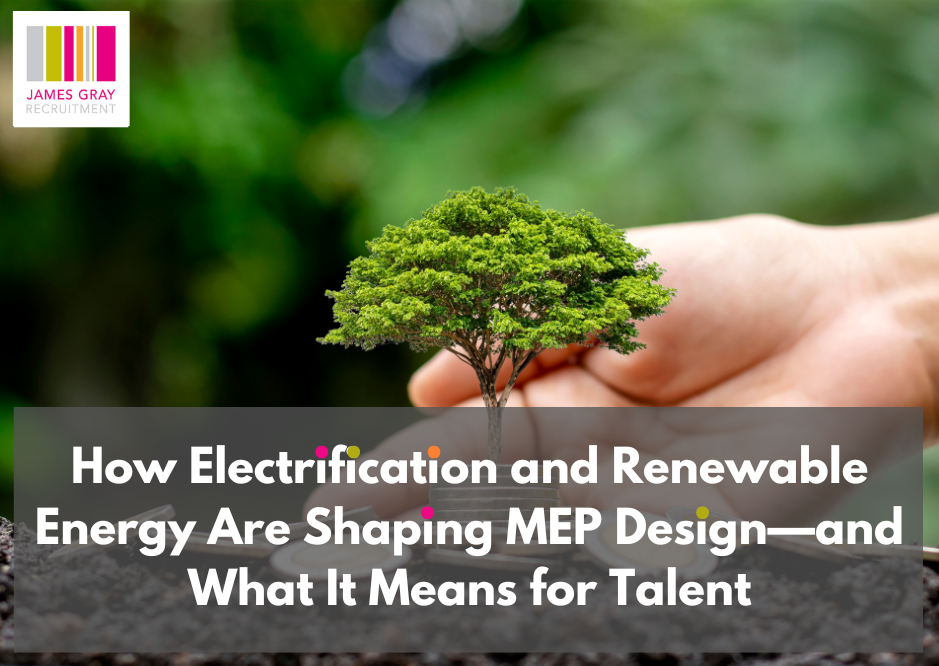
How Electrification and Renewable Energy Are Shaping MEP Design
The shift towards electrification and renewable energy in the MEP (Mechanical, Electrical, and Plumbing) design sector isn't just a trend—it's a transformation. As a recruitment consultant working closely with both clients and candidates across the MEP landscape, I've seen firsthand how this pivot is redefining not only how buildings are powered and serviced but also what skills and mindsets are now in highest demand.
Let’s explore what this shift means for the industry, and more importantly, for the people working within it.
Why Electrification Is Taking Center Stage
In recent years, sustainability has evolved from a buzzword to a business imperative. Clients—from commercial developers to public institutions—are demanding buildings that are energy-efficient, low-emission, and future-ready.
As a result, MEP firms are rapidly transitioning from traditional gas-powered systems to fully electric HVAC, hot water, and energy systems. Pair that with a surge in solar panels, battery storage, EV charging infrastructure, and smart grids, and you’ve got a radically changing design environment.
This shift is not just about complying with updated codes or green certifications—it's about future-proofing buildings and aligning with global carbon-neutral targets. Cities and countries are phasing out fossil fuel-based systems, and clients want designs that don’t need retrofitting in five years.
What Clients Are Asking For
As a consultant, I often speak to hiring managers struggling to find the right mix of innovation, compliance, and execution in their teams. Here's what clients are telling me:
- “We need someone who understands electric heat pump design and how to integrate it seamlessly into residential and commercial projects.”
- “Experience with solar integration, battery storage, and power management systems is becoming non-negotiable.”
- “Candidates with exposure to smart buildings and IoT-driven energy systems give us a real edge in proposals.”
What we’re witnessing is a hybridisation of roles—designers who understand not just traditional MEP systems, but also energy modelling, controls, and renewable technologies.
What Candidates Should Focus On
If you’re an MEP professional looking to stay competitive—or make a big leap forward—here’s where to focus:
- Upskill in Electrical Design: Even mechanical engineers are being expected to understand basic electrical principles. Tools like Revit MEP, AutoCAD Electrical, and energy modelling software are fast becoming baseline requirements.
- Learn Renewable Integration: From photovoltaic arrays to grid-connected battery systems, having experience or training in renewable energy is a major plus. Many candidates are now taking short courses in solar design and net-zero strategies.
- Understand Regulatory Shifts: Keeping up to date with Part L, ASHRAE, and city-level net-zero policies can make you a go-to resource on any team.
- Showcase Project Experience: If you’ve worked on electrified or renewable-integrated projects, make sure your CV reflects that. Hiring managers are scanning for real-world application, not just theoretical knowledge.
Challenges We’re Seeing in the Market
This transition isn't without its growing pains. Clients are often looking for a “unicorn”—a designer who can handle traditional MEP design but also bring cutting-edge energy expertise. Meanwhile, candidates can feel overwhelmed trying to predict which skills will remain relevant.
That’s where we come in as recruiters: matching forward-thinking talent with visionary firms who understand the value of investing in their people and tech stacks.
The key is communication—clients need to define which skills are must-haves versus trainable, and candidates need to articulate not just what they’ve done, but how they’re adapting for the future.
Final Thoughts
Electrification and renewable energy are more than engineering concerns—they’re shaping the future of our cities, our buildings, and our careers. As the MEP sector leans into this shift, the demand for versatile, curious, and sustainability-driven professionals will only increase.
Whether you’re hiring or job hunting, now is the time to align with the future. If you're unsure how to navigate these changes, let’s connect—I’m always happy to share insights on where the market is heading and how you can stay ahead of the curve.
Want to talk about electrification-ready talent or opportunities in the MEP sector?
getus@jamesgrayrecruitment.com
+1 646 513 2747

